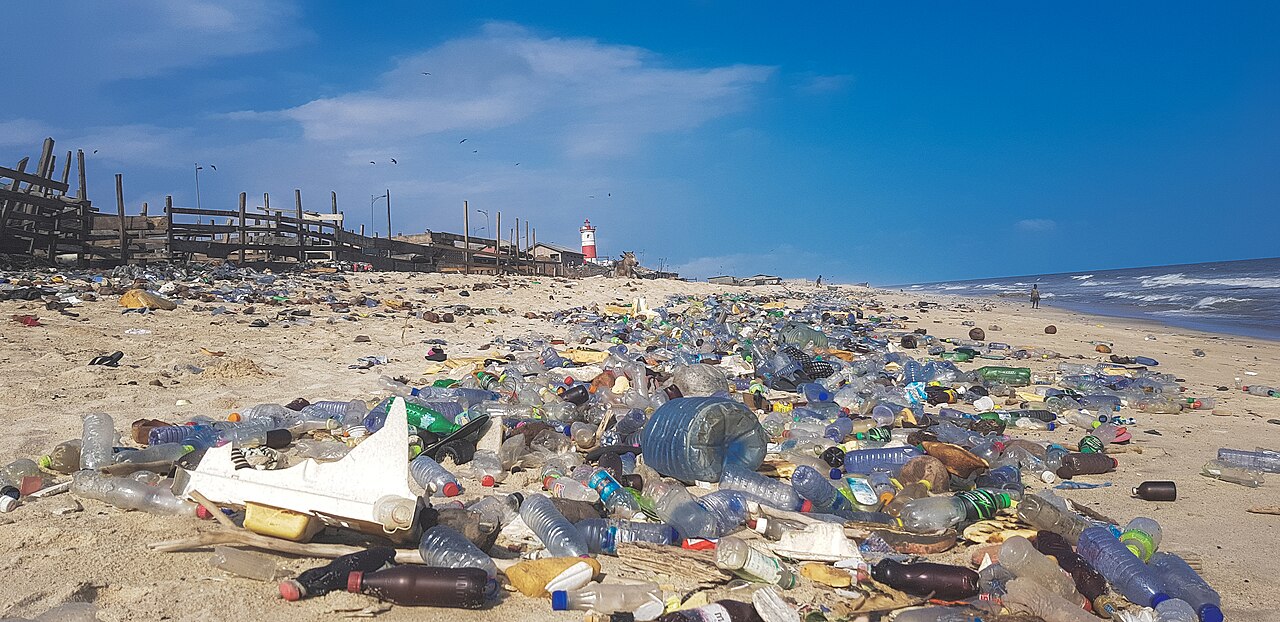
Credit: Muntaka Chasant, CC BY-SA 4.0, via Wikimedia Commons
Background
Synopsis: Since the 1950s, plastic pollution has increased at an alarming rate, with a significant portion entering the world’s oceans. This waste poses a grave threat to the fish, birds, and mammals that inhabit these ecosystems. As a human-made problem, it is our responsibility to take action and develop sustainable solutions to protect marine life, preserve the health of the oceans, and in the end preserve our own future.
Effects of Plastic in the Ocean
- It is estimated that every year, 10-12 million tons of plastic pollution enters the world’s oceans. That is the equivalent of a garbage truck full of plastic dumping its load into the ocean every 45 seconds! This affects organisms in the ocean as well as those along the shorelines.
- Hermit crabs play a vital role in ecosystems for seed dispersal, nutrient cycling, as scavengers, and in symbiotic relationships.
- When hermit crabs hunt for a new shell, they oftentimes get trapped inside plastic bottles or containers on beaches. When the crab dies inside the garbage, the dying crab releases a scent that informs other crabs that their shell is available. This has a devastating chain-reaction affect as other crabs go into the container and get trapped as well.
- A year-long study completed in 2020 on two remote islands off the coast of Australia showed that nearly 500,000 crabs became trapped, mostly in plastic water bottles.
- Sea turtles can often confuse floating plastic debris for their favorite food, jellyfish. One study examined the stomachs of the seven types of sea turtles from across the globe. Of the 100 sea turtles tested, every one of the sea turtles had microplastics in their stomachs.
- This can be especially harmful for baby sea turtles, as ingesting just half a gram – the weight of a plastic straw – can be deadly.
- Even large whales suffer from plastics in the ocean. Off the Florida Keys, an emaciated 47-foot (14.5 meters) sperm whale was found to have died when ingested plastic fishing nets, fishing line, and plastic bags blocked food from entering its stomach.
- A beached pilot whale along the coast of Indonesia was found to have over 17 pounds (7.7 kg) of plastic in its stomach, including flip flops and plastic bags.
- In the 1960s, five percent of shore birds were found with plastic in their stomachs. By the 1980s, over eighty percent of shore birds had ingested plastics with the number expected to grow to 99% by 2050.
- The birds are unable to digest the plastic, and it then fills their stomachs, leading to starvation.
- On Midway Island, 2000 miles (3220 km) from a major continent, it is estimated that 100 pounds (45 kg) of plastic wash up on the shore each week.
- As a result, approximately one-third of the albatross chicks born on the island die from plastic pollution when the parents mistakenly feed the chicks plastic, thinking the plastic pieces are prey.
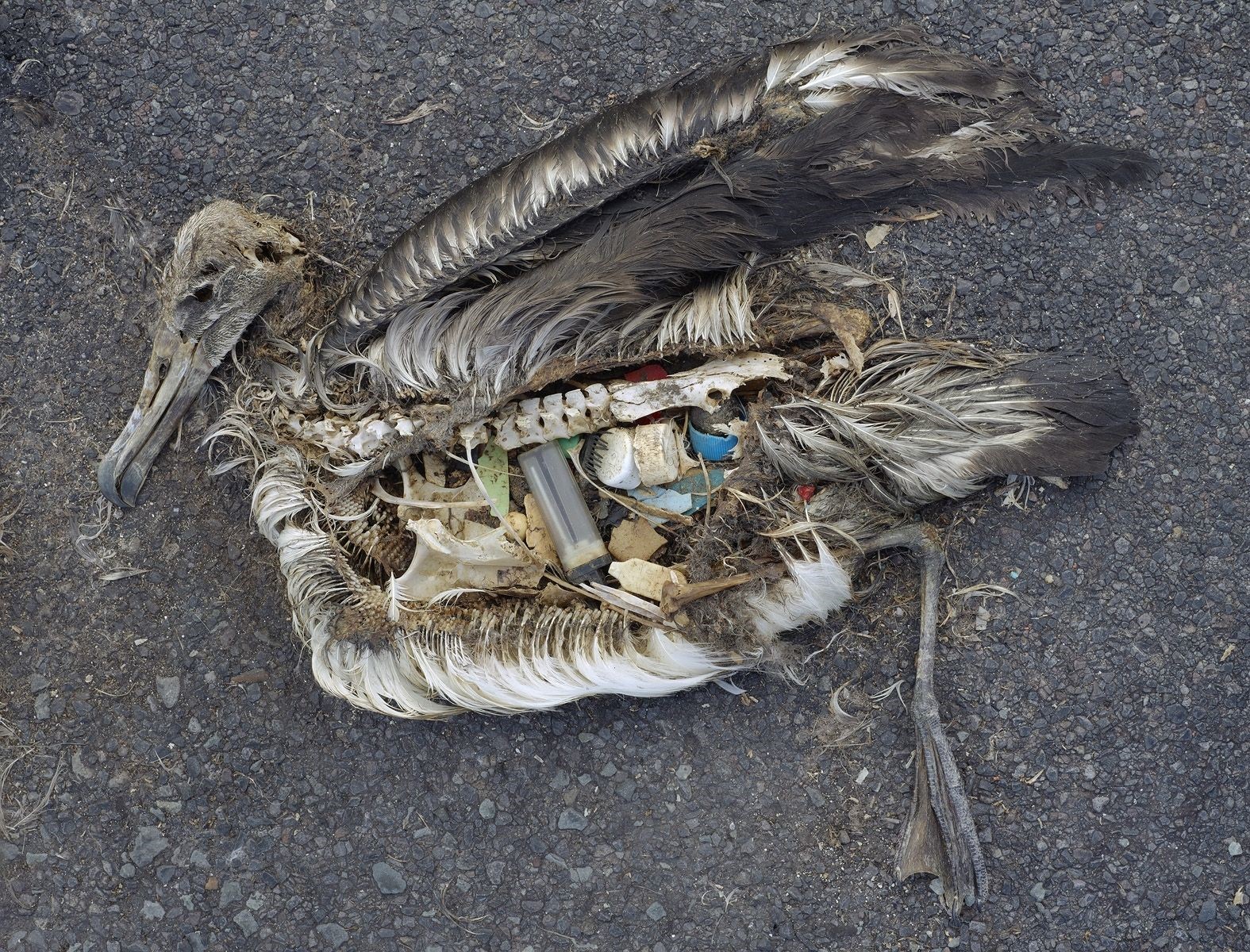
The unaltered stomach contents of a dead albatross chick photographed on Midway Atoll National Wildlife Refuge in the Pacific in September 2009 include plastic marine debris fed the chick by its parents.
Credit: Chris Jordan (via U.S. Fish and Wildlife Service Headquarters), CC BY-SA 2.0, via Wikimedia Commons
- As a result, approximately one-third of the albatross chicks born on the island die from plastic pollution when the parents mistakenly feed the chicks plastic, thinking the plastic pieces are prey.
- Hermit crabs play a vital role in ecosystems for seed dispersal, nutrient cycling, as scavengers, and in symbiotic relationships.
The Origin of Plastics
- Bakelite was the first fully synthetic plastic, created in 1907 as an insulating material for the growing electrical industry. The new material was promoted as having “thousands of uses” and was soon found in everything from telephones to jewelry.
- Nylon was the first synthetic fabric and was developed for use during World War II to be used for parachutes, rope, helmet liners, and more. The use of plastics boomed after the war. According to author Susan Freinkel, “In product after product, market after market, plastics challenged traditional materials and won, taking the place of steel in cars, paper and glass in packaging, and wood in furniture.”
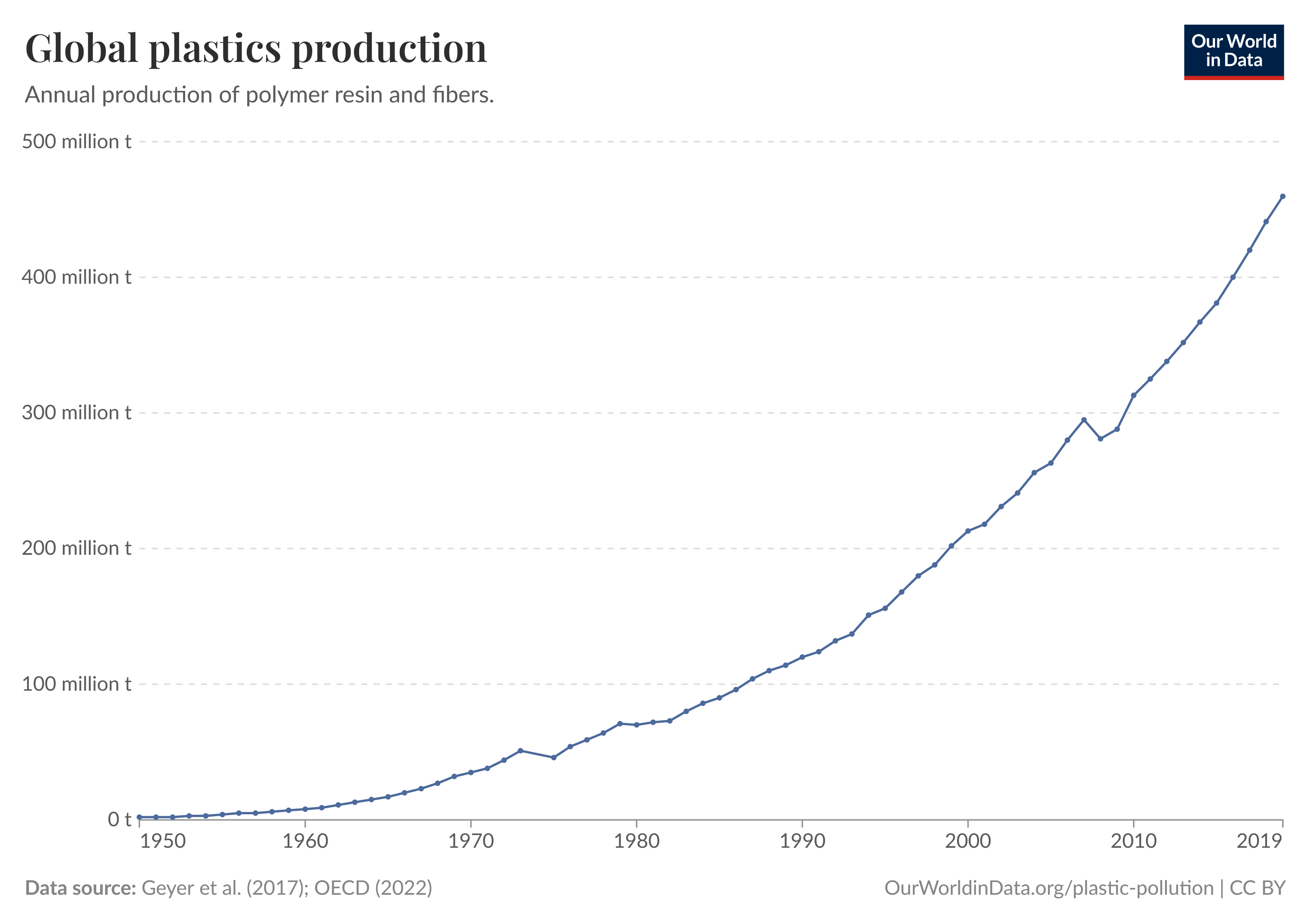
In the last two decades, plastic production has doubled.
Credit: H. Ritchie et al. (2023), CC BY 4.0, via Our World in Data
The Problem with Plastics
- A study from 2021 reported that 50% of plastics are single use, with most of these originating from the food and beverage industry.
- Most plastics follow a linear economy model, one that follows the idea that the natural resources are taken, a plastic is made, the product is used, and then the product is disposed of. From 1950 to 2015, only 10% of plastic was recycled.
- The EPA states that “every bit of plastic ever made still exists.”
- Most plastics are made of long chains of hydrocarbons with high molecular weights. This makes plastic very stable chemically and unlikely to biodegrade on land or in water.
- Plastic does, however, weather and erode, breaking into smaller and smaller plastic bits called microplastics. These can be from 5 millimeters, about the size of a sesame seed, to as small as 1 nanometer, needing an electron microscope to see.
- Plastic enters waterways when individuals litter, either on purpose or unintendedly. Plastics then enter waterways when it rains, and runoff occurs or enter through storm drains.
- Wastewater treatment facilities do not have the means to trap microplastics and thus they are passed along through the treatment process, locally ending up in a river which eventually reaches an ocean.
- As a result, all five of Earth’s major ocean gyres are inundated with plastic pollution. The largest is in the Pacific Ocean, known as the Great Pacific Garbage Patch and covering 620,000 square miles (1.6 million square kilometers). If this patch of garbage were on land, it would cover the states of Texas, Oklahoma, New Mexico, and most of Arizona.
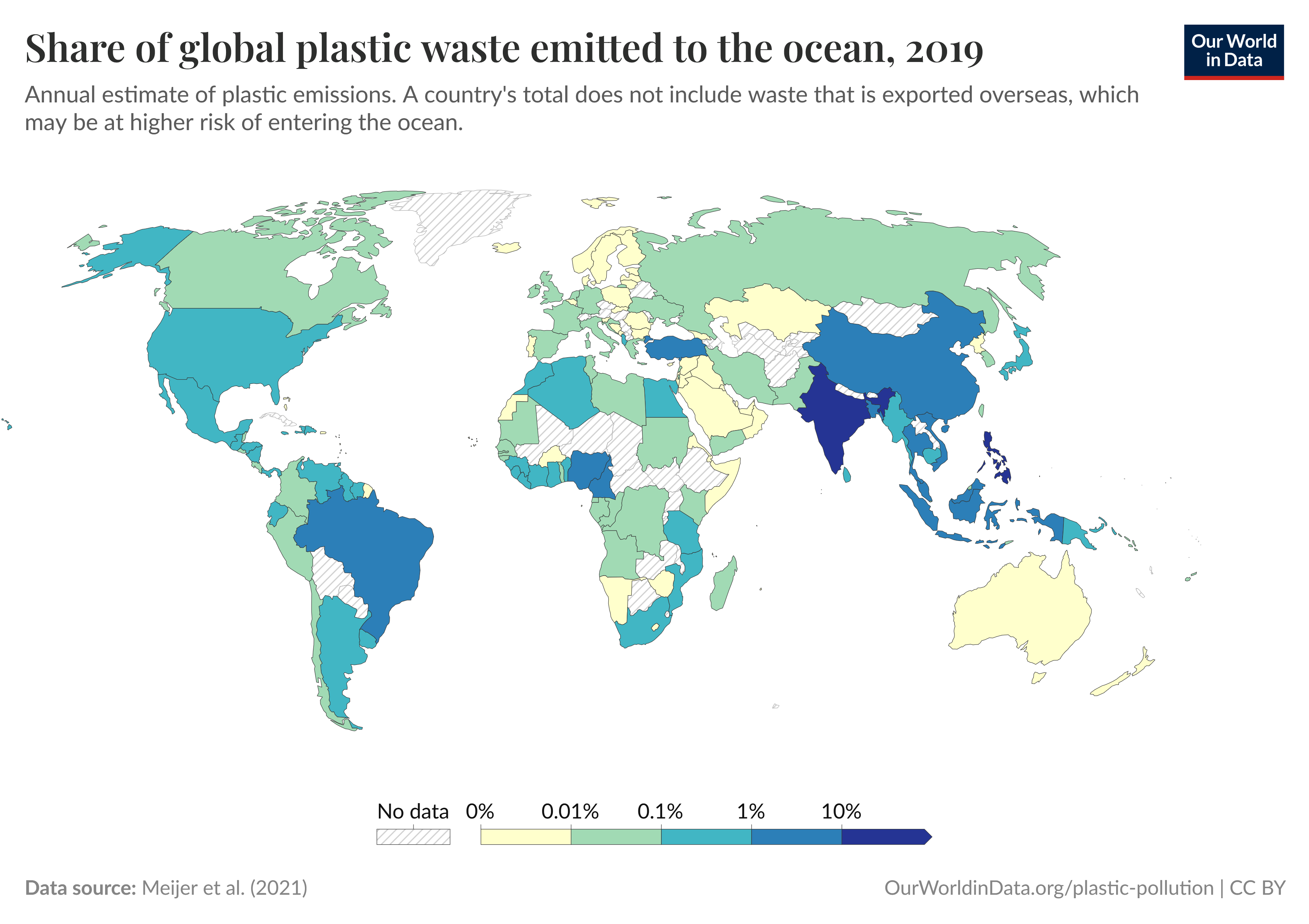
Asia accounts for 81% of the plastics that enter the world’s oceans with one-third of the total input of plastics coming from the Philippines. The Pasig River in the Philippines adds over 6% of the total plastic waste. The Philippines has a large portion of their population living near coastal areas as the country is comprised of many small islands. The country also has poor waste management practices which contribute to this large amount.
Credit: H. Ritchie et al. (2023), CC BY 4.0, via Our World in Data
What can be done?
- Reducing the harm of plastic pollution requires action on multiple levels -- individual, community, and global.
- Avoiding single-use items like plastic bottles, straws, and bags can significantly reduce the volume of plastics entering the ocean. Simple changes, such as using reusable shopping bags and water bottles, can have a large impact when adopted widely.
- Supporting the development and use of biodegradable or plant-based plastics can help reduce long-term pollution. While not perfect solutions, these materials break down more easily than traditional plastics and pose less risk to marine ecosystems.
- Shifting from a linear economy (make, use, dispose of) to a circular economy emphasizes reusing, repairing, and recycling products. This approach minimizes waste and the demand for new plastic production, reducing the overall environmental impact.
- Participating in beach cleanups, supporting local recycling programs, and educating others about the impacts of ocean plastic can amplify efforts to combat pollution.
- Governments and industries can play a crucial role by introducing regulations to limit plastic production and waste, incentivizing sustainable packaging, and investing in innovative materials. For example, refill stations for household products and reusable packaging initiatives are gaining traction in several countries.
- Knowledge is a key driver of change. Funding scientific research into the impacts of plastics and potential solutions can help guide more effective actions. Raising awareness about the harm plastic pollution causes to marine life can also inspire others to act.
- Marine ecosystems are intricate and interdependent, supporting a vast array of life, including fish, mammals, birds, and humans. Protecting our oceans from plastic pollution is essential to preserve biodiversity and maintain the health of our planet. Every effort, no matter how small, contributes to reversing the tide of pollution and securing a sustainable future for generations to come.
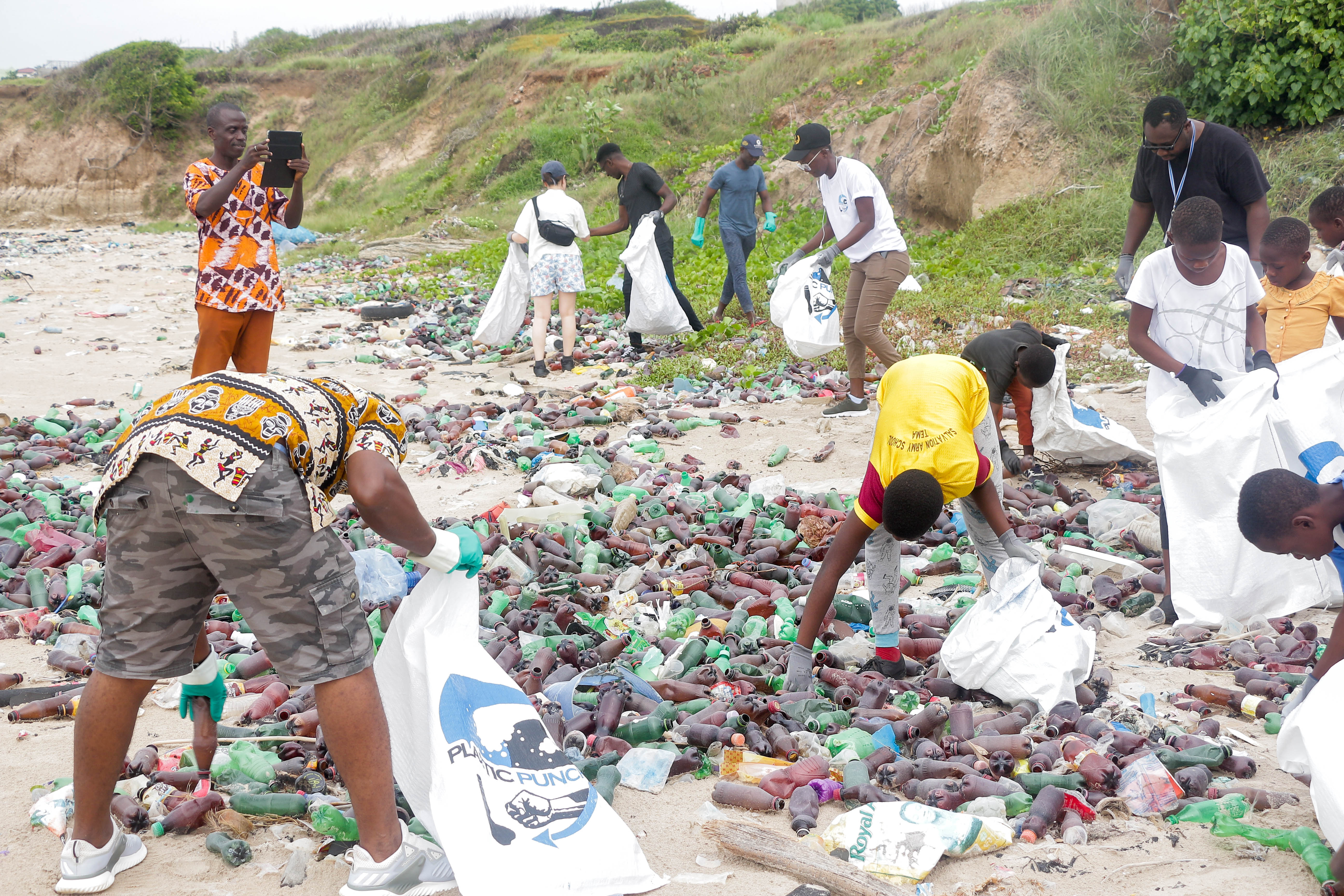
Volunteers in Ghana cleaning a beach.
Credit: Fquasie, CC BY-SA 4.0, via Wikimedia Commons
Episode script
When plastics were introduced, they replaced glass, metal, paper and wood in many applications.
That’s because plastic is a miracle. It’s cheap, light, can be formed into millions of products, and is incredibly durable.
But these big benefits have led to a very big problem. Plastic pollution is now everywhere. And because it’s so durable, it’s not going away.
Plastic pollution starts with us, mostly with single use plastics – bottles, cups, straws and bags, used once then discarded. Single use plastics make up half of all plastic waste.
Very little is recycled. The plastic that doesn’t go to landfills may be shipped to other countries, or scattered as litter, and eventually gets washed into rivers and oceans, where it stays.
There’s now a spinning garbage patch of plastic in the Pacific Ocean the size of Alaska!
Nearly all sea turtles and large ocean mammals, like whales, have plastic waste stuck in their digestive systems.
Nearly all seabirds, too. Small bits of plastic, which they mistake for prey, can eventually fill their stomachs, killing them.
Plastic pollution is in all of us too. It breaks down into tiny particles called microplastics, which get into our water supply and food.
But each of us can do something about it – starting by avoiding single use plastics.
We caused the plastic pollution problem; it’s up to us to fix it.

